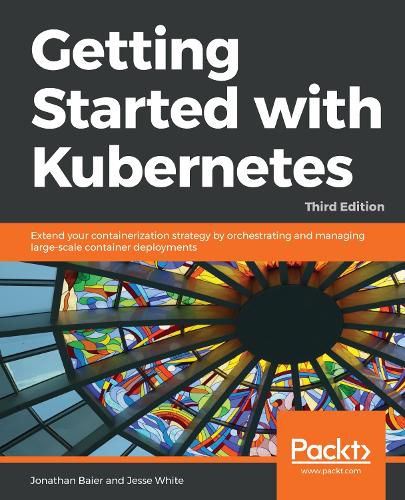Readings Newsletter
Become a Readings Member to make your shopping experience even easier.
Sign in or sign up for free!
You’re not far away from qualifying for FREE standard shipping within Australia
You’ve qualified for FREE standard shipping within Australia
The cart is loading…






This title is printed to order. This book may have been self-published. If so, we cannot guarantee the quality of the content. In the main most books will have gone through the editing process however some may not. We therefore suggest that you be aware of this before ordering this book. If in doubt check either the author or publisher’s details as we are unable to accept any returns unless they are faulty. Please contact us if you have any questions.
Schedule and run application containers using Kubernetes
Key Features
Get to grips with a wide range of tools to monitor and secure your deployments Manage your container clusters and networks using Kubernetes Get well-versed with the fundamentals of Kubernetes
Book DescriptionKubernetes has continued to grow and achieve broad adoption across various industries, helping you to orchestrate and automate container deployments on a massive scale.
Based on the recent release of Kubernetes 1.12, Getting Started with Kubernetes gives you a complete understanding of how to install a Kubernetes cluster. The book focuses on core Kubernetes constructs, such as pods, services, replica sets, replication controllers, and labels. You will understand cluster-level networking in Kubernetes, and learn to set up external access to applications running in the cluster.
As you make your way through the book, you’ll understand how to manage deployments and perform updates with minimal downtime. In addition to this, you will explore operational aspects of Kubernetes , such as monitoring and logging, later moving on to advanced concepts such as container security and cluster federation. You’ll get to grips with integrating your build pipeline and deployments within a Kubernetes cluster, and be able to understand and interact with open source projects. In the concluding chapters, you’ll orchestrate updates behind the scenes, avoid downtime on your cluster, and deal with underlying cloud provider instability within your cluster.
By the end of this book, you’ll have a complete understanding of the Kubernetes platform and will start deploying applications on it.
What you will learn
Download, install, and configure the Kubernetes code base Set up and access monitoring and logging for Kubernetes clusters Set up external access to applications running in the cluster Learn how to manage and scale kubernetes with hosted platforms on AWS, Azure, and GCP Run multiple clusters and manage them from a single control plane Discover top tools for deploying and managing a Kubernetes cluster Learn how to get production ready and harden Kubernetes operations, networking, and storage
Who this book is forGetting Started with Kubernetes is for developers, system administrators, and DevOps engineers who want to automate the deployment process and scale their applications. No prior knowledge of Kubernetes is required.
$9.00 standard shipping within Australia
FREE standard shipping within Australia for orders over $100.00
Express & International shipping calculated at checkout
This title is printed to order. This book may have been self-published. If so, we cannot guarantee the quality of the content. In the main most books will have gone through the editing process however some may not. We therefore suggest that you be aware of this before ordering this book. If in doubt check either the author or publisher’s details as we are unable to accept any returns unless they are faulty. Please contact us if you have any questions.
Schedule and run application containers using Kubernetes
Key Features
Get to grips with a wide range of tools to monitor and secure your deployments Manage your container clusters and networks using Kubernetes Get well-versed with the fundamentals of Kubernetes
Book DescriptionKubernetes has continued to grow and achieve broad adoption across various industries, helping you to orchestrate and automate container deployments on a massive scale.
Based on the recent release of Kubernetes 1.12, Getting Started with Kubernetes gives you a complete understanding of how to install a Kubernetes cluster. The book focuses on core Kubernetes constructs, such as pods, services, replica sets, replication controllers, and labels. You will understand cluster-level networking in Kubernetes, and learn to set up external access to applications running in the cluster.
As you make your way through the book, you’ll understand how to manage deployments and perform updates with minimal downtime. In addition to this, you will explore operational aspects of Kubernetes , such as monitoring and logging, later moving on to advanced concepts such as container security and cluster federation. You’ll get to grips with integrating your build pipeline and deployments within a Kubernetes cluster, and be able to understand and interact with open source projects. In the concluding chapters, you’ll orchestrate updates behind the scenes, avoid downtime on your cluster, and deal with underlying cloud provider instability within your cluster.
By the end of this book, you’ll have a complete understanding of the Kubernetes platform and will start deploying applications on it.
What you will learn
Download, install, and configure the Kubernetes code base Set up and access monitoring and logging for Kubernetes clusters Set up external access to applications running in the cluster Learn how to manage and scale kubernetes with hosted platforms on AWS, Azure, and GCP Run multiple clusters and manage them from a single control plane Discover top tools for deploying and managing a Kubernetes cluster Learn how to get production ready and harden Kubernetes operations, networking, and storage
Who this book is forGetting Started with Kubernetes is for developers, system administrators, and DevOps engineers who want to automate the deployment process and scale their applications. No prior knowledge of Kubernetes is required.